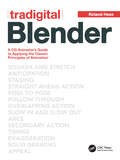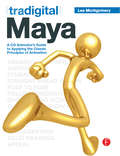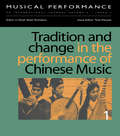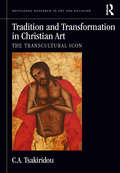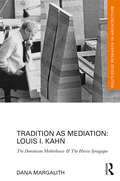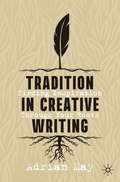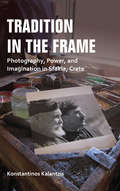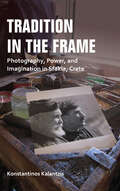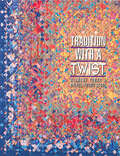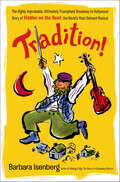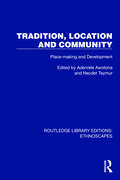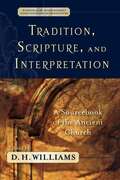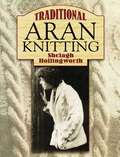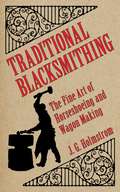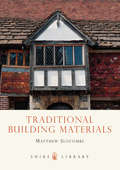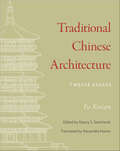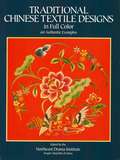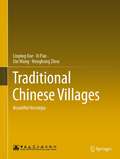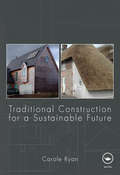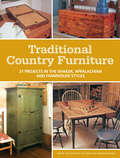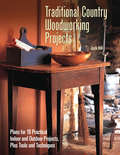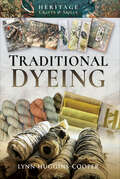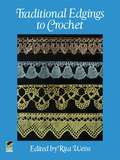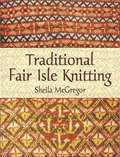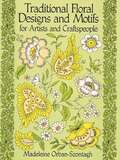- Table View
- List View
Tradigital Blender: A CG Animator's Guide to Applying the Classical Principles of Animation
by Roland HessExpand your animation toolkit with foundational animation techniques, software expertise, professional best-practices, proven and time-tested work flows. Roland Hess, a leading Blender artist and instructor, expertly navigates you through Blender's character animation systems and controls, with a focus on each of the classical principles of animation like timing, anticipation, appeal, staging, exaggeration, squash and stretch and much more. Unique from other software titles, the Tradigital series offers a specific tool-set of practical instruction and foundational knowledge that all great animators will need to know. Expand your digital workflow to include the practical resources with the robust companion web site that include demonstrations, project files, links to further resources, available at www.tradigitalblender.com.
Tradigital Maya: A CG Animator's Guide to Applying the Classical Principles of Animation
by Lee MontgomeryExplore Disney's 12 principles of animation, while learning how to animate in Maya. You can develop your own leading digital techniques rooted to traditional workflows. From squash and stretch to timing and appeal, you will enhance your creative toolset with strong classics training and cutting edge techniques. Trusted Maya Authority, Lee Montgomery offers the only artistic guide to applying the principles of traditional animation with Maya's tools, which are used in production by the best animators and VFX artists today. Add another webpage to your favourites and expand your digital workflow to include the practical resources of the Tradigital Maya with the robust companion web site that include demonstrations, project files, links to further resources, available at www.tradigitalmaya.com.
Tradition & Change Performance (Musical Performance Ser. #Vols. 2, Pts. 2.)
by TsaoFirst published in 1998. Routledge is an imprint of Taylor & Francis, an informa company.
Tradition and Transformation in Christian Art: The Transcultural Icon (Routledge Research in Art and Religion)
by C.A. TsakiridouTradition and Transformation in Christian Art approaches tradition and transculturality in religious art from an Orthodox perspective that defines tradition as a dynamic field of exchanges and synergies between iconographic types and their variants. Relying on a new ontology of iconographic types, it explores one of the most significant ascetical and eschatological Christian images, the King of Glory (Man of Sorrows). This icon of the dead-living Christ originated in Byzantium, migrated west, and was promoted in the New World by Franciscan and Dominican missions. Themes include tensions between Byzantine and Latin spiritualities of penance and salvation, the participation of the body and gender in deification, and the theological plasticity of the Christian imaginary. Primitivist tendencies in Christian eschatology and modernism place avant-garde interest in New Mexican santos and Greek icons in tradition.
Tradition as Mediation: The Dominican Motherhouse & The Hurva Synagogue (Routledge Research in Architecture)
by Dana MargalithThis book explores Louis I. Kahn's approach to tradition as revealed in two of his important, unbuilt, projects. Focusing on Kahn's designs for the Dominican Motherhouse of St. Catherine de Ricci, Media, Pennsylvania (1965-1969), and the Hurva Synagogue, Jerusalem, Israel (1967-1974), the book challenges prevailing aesthetic and methodological assessments of Kahn's use of tradition. It reveals how an authentic and critical theoretical-historical and humanistic study of tradition nourished Kahn's designs, enabling him to mediate historical rituals, ideas and beliefs – and to develop innovative designs rooted deep in human culture while addressing real modern concerns. The book evaluates Kahn's works as a creative recreation and re-interpretation of the past, shedding light on the potential value of the meaningful consideration of tradition in modern times.
Tradition in Creative Writing: Finding Inspiration Through Your Roots
by Adrian MayTradition in Creative Writing: Finding Inspiration Through Your Roots encourages writers to rediscover sources of creativity in the everyday, showing students how to see your writing as connected to your life. Adrian May addresses a key question for many beginning writers: Where do you get your ideas from? May argues that tradition does not mean anti-progress—but is instead a kind of hidden wealth that stems from literary and historical traditions, folk and songs, self and nature, and community. By drawing on these personal and traditional wellsprings of inspiration, writers will learn to see their writing as part of a greater continuum of influences and view their work as having innate value as part of that cultural and artistic ecology. Each chapter includes accessible discussion, literary and critical readings, creative examples, and writing exercises. While the creative examples are drawn from song lyrics and poetry, the writing exercises are appropriate for all genres. Undergraduates and practitioners will benefit from this guide to finding originality in writing through exploring sources of creative inspiration.
Tradition in the Frame: Photography, Power, and Imagination in Sfakia, Crete (New Anthropologies of Europe)
by KONSTANTINOS KALANTZISSfakians on the island of Crete are known for their distinctive dress and appearance, fierce ruggedness, and devotion to traditional ways. Konstantinos Kalantzis explores how Sfakians live with the burdens and pleasures of maintaining these expectations of exoticism for themselves, for their fellow Greeks, and for tourists. Sfakian performance of masculine tradition has become even more meaningful for Greeks looking to reimagine their nation’s global standing in the wake of stringent financial regulation, and for non-Greek tourists yearning for rootedness and escape from the post-industrial north. Through fine-grained ethnography that pays special attention to photography, Tradition in the Frame explores the ambivalence of a society expected to conform to outsiders’ perception of the traditional even as it strives to enact its own vision of tradition. From the bodily reenactment of historical photographs to the unpredictable, emotionally-charged uses of postcards and commercial labels, the book unpacks the question of power and asymmetry but also uncovers other political possibilities that are nested in visual culture and experiences of tradition and the past. Kalantzis explores the crossroads of cultural performance and social imagination where the frame is both empowerment and subjection.
Tradition in the Frame: Photography, Power, and Imagination in Sfakia, Crete (New Anthropologies of Europe)
by Konstantinos KalantzisAn ethnographic study of a Greek island community’s culture in the face of modern times.Sfakians on the island of Crete are known for their distinctive dress and appearance, fierce ruggedness, and devotion to traditional ways. Konstantinos Kalantzis explores how Sfakians live with the burdens and pleasures of maintaining these expectations of exoticism for themselves, for their fellow Greeks, and for tourists. Sfakian performance of masculine tradition has become even more meaningful for Greeks looking to reimagine their nation’s global standing in the wake of stringent financial regulation, and for non-Greek tourists yearning for rootedness and escape from the post-industrial north. Through fine-grained ethnography that pays special attention to photography, Tradition in the Frame explores the ambivalence of a society expected to conform to outsiders’ perception of the traditional even as it strives to enact its own vision of tradition. From the bodily reenactment of historical photographs to the unpredictable, emotionally-charged uses of postcards and commercial labels, the book unpacks the question of power and asymmetry but also uncovers other political possibilities that are nested in visual culture and experiences of tradition and the past. Kalantzis explores the crossroads of cultural performance and social imagination where the frame is both empowerment and subjection.“In this original, beautifully written, and often moving monograph, Konstantinos Kalantzis has produced a lasting contribution to the anthropological study of contemporary Europe. Drawing on extensive fieldwork, Tradition in the Frame explores with exquisite detail a number of timely themes—the social life of photographs, conflicting tourist and local images of Crete, the performance of gender stereotypes, and the complex tension between tradition and modernity. The author’s ability to view the world through the eyes of natives and foreigners, and to deconstruct visual signs and symbols, is nothing short of stunning. For anyone interested in Europe and the Mediterranean world today, this richly documented and theoretically sophisticated volume is a must read.” —Stanley Brandes“Tradition in the Frame is a richly innovative ethnography focusing on the visual dimensions of modern Cretan mythmaking, and especially on the material reproduction and negotiation of time-honored stereotypes of warrior masculinity. Writing of a society that has largely shifted its economy from shepherding to tourism, Kalantzis incisively demonstrates how the realities of commercial exploitation and socio-political change re-frame familiar images of a society at once proudly central to the symbolism of national identity and yet also still reluctant to accept the merest hint of intrusive authority.” —Michael Herzfeld
Tradition with a Twist: Variations on Your Favorite Quilts
by Blanche Young Dalene Young-StonePut a new twist on your favorite traditional quilt designs with this guide featuring creative fabrics and modern, time-saving techniques! Legendary quilters Blanch Young and Dalene Young-Stone present a new twist on traditional quilt patterns including Boston Commons, Trip Around the World, Sunshine and Shadow, Nine Patch, Irish Chain, and more using new construction methods and composing with an exciting palette of contemporary fabrics. The authors introduce the basics of working with fabric to create strip sets to easily construct magnificent quilts. Their streamlined techniques were developed to get traditional quality results using the tools of today, such as rotary cutters and cutting mats.
Tradition!: The Highly Improbable, Ultimately Triumphant Broadway-to-Hollywood Story of Fiddler on the Roof, the World's Most Beloved Musical
by Barbara IsenbergSince it first opened on Broadway in September, 1964, Fiddler on the Roof has constantly been onstage somewhere, including four Broadway revivals, four productions on London's West End and thousands of schools, army bases and countries from Argentina to Japan. Barbara Isenberg interviewed the men and women behind the original production, the film and significant revivals--Harold Prince, Sheldon Harnick, Joseph Stein, Austin Pendleton, Joanna Merlin, Norman Jewison, Topol, Harvey Fierstein and more--to produce a lively, popular chronicle of the making of Fiddler. Published in celebration of Fiddler's 50th anniversary, Tradition! is the book for everyone who loves Fiddler and can sing along with the original cast album.
Tradition, Location and Community: Place-making and Development (Routledge Library Editions: Ethnoscapes)
by Adenrele Awotona Necdet TeymurOriginally published in 1997, as part of the Ethnoscapes: Current Challenges in the Environmental Social Sciences series, reissued now with a new series introduction, Tradition, Location and Community: Place-making and Development brings together the selected papers of seventeen architects, social scientists and planners. It offers a range of original perspectives on the relationship between the design and habituation of the built environment on the one hand and social and cultural development on the other. As an archival volume, it attempts to present a mixture of cross-disciplinary and cross-cultural perspectives. It explores the view that planning and design (the organization of the physical/built environment) which follow from the rapid transformations wrought by development must respond to, and be based on, the wants and needs of the people affected; that is, it must be in accord with their notions of environmental quality.Divided into two sections. The first section has five chapters which explore the theoretical and conceptual aspects of place-making and development. Section two consists of twelve chapters, each of which presents a case study.
Tradition, Scripture, and Interpretation: A Sourcebook of the Ancient Church (Evangelical Ressourcement)
by D. H. WilliamsTradition, Scripture, and Interpretation supplements a valuable series that helps modern church leaders return to the wisdom and insight of the early church fathers in order to apply their ancient understandings of Christian belief and practice to ministry in the twenty-first century. This sourcebook gathers key writings from the first through sixth centuries on various topics of concern to the church yesterday and today. The writings are arranged thematically, and within each theme, chronologically, revealing how the Christian tradition on a given topic developed over time. The anthology begins with a chapter examining the close relationship between Scripture and tradition in the minds of early church leaders.
Traditional Aran Knitting
by Shelagh HollingworthMore than 20 fully illustrated project patterns for knitters of all abilities. Known and prized around the world in the form of the "Irish fisherman's sweater," Aran knitting originated generations ago in the chilly, windswept islands of Galway Bay. The seafaring Aran Islanders developed a distinctive method of crafting heavy wool into snug garments resistant to the stormiest weather. These clothes also happen to be extremely stylish, with distinctive, highly textured patterns of cables and ropes.Suitable for novices to the Aran style as well as for experienced knitters, this guide offers start-to-finish advice. More than 20 patterns, illustrated by 117 close-up photographs, include:* Traditional fisherman's sweater* Family sweater, with round, polo, or V-neck* Cardigans* Jackets and coats* Hat, mittens, and scarf set* Cushion coversTraditional Aran Knitting also explains the history of the craft and the meaning behind the coded "messages" woven into the unique Aran patterns.
Traditional Blacksmithing: The Fine Art of Horseshoeing and Wagon Making
by J G HolmstromOnly an experienced blacksmith with genuine care for his craft and the livelihood of all blacksmiths could produce such a wonderful guide. Holmstrom provides not just practical instruction for all manner of small-scale blacksmith work, but intersperses his guidance with more general life lessons for blacksmiths, such as not falling prey to "habits of intemperance." More than a snapshot of a bygone era, the style and the content of Traditional Blacksmithing will appeal to readers of today, thanks to Holmstrom's generous and patient approach. Topics covered include: setting up shop, building your own machinery, repairing horse hooves, fixing your tools, and even building a strong reputation in the community.
Traditional Building Materials
by Matthew SlocombeSteel and glass now dominate modern British cities, but the country can still boast millions of older houses constructed of more traditional building materials. Many date from the period before easy nationwide transportation, when these materials were usually grown on or extracted from land in the locality. As a result, Britain has a varied legacy of vernacular buildings that echoes its multitude of different landscapes. They display a rich and colourful palette of materials from the honey-coloured stone of the Cotswolds, to the red earth of Devon and grey granite of Aberdeen. In this book, buildings historian Matthew Slocombe explores the way in which locally produced constructional resources have shaped Britain's architectural heritage, whether workers' cottages or country houses. He looks at the range of materials used for walls and roof coverings, and explores the processes needed for their extraction, production and manufacture. He also considers the wealth of craft skills required for their use, including masonry, carpentry, roofing, leadwork and much more.
Traditional Chinese Architecture: Twelve Essays (The Princeton-China Series)
by Fu XinianA groundbreaking book by one of the world's leading historians of Chinese architectureTranslated by Alexandra Harrer.Fu Xinian is considered by many to be the world's leading historian of Chinese architecture. He is an expert on every type of Chinese architecture from every period through the nineteenth century, and his work is at the cutting edge of the field. Traditional Chinese Architecture gathers together, for the first time in English, twelve seminal essays by Fu Xinian. This wide-ranging book pays special attention to the technical aspects of the building tradition since the first millennium BC, and Fu Xinian's signature drawings abundantly illustrate its nuances.The essays delve into the modular basis for individual structures, complexes, and cities; lateral and longitudinal building frames; the unity of sculpture and building to create viewing angles; the influence of Chinese construction on Japanese architecture; and the reliability of images to inform us about architecture. Organized chronologically, the book also examines such topics as the representation of architecture on vessels in the Warring States period, early Buddhist architecture, and the evolution of imperial architecture from the Tang to Ming dynasty. A biography of Fu Xinian and a detailed Chinese-English glossary are included.Bringing together some of the most groundbreaking scholarship in Chinese architectural history, Traditional Chinese Architecture showcases an uncontested master of the discipline.
Traditional Chinese Textile Designs in Full Color
by Northeast Drama InstituteSixty authentic full-color motifs drawn from highly stylized opera traditions. Symbolic representations of dragons, lions, phoenixes, mandarin ducks, cranes, peonies, lotuses, much more. Vibrant color, subtle hues, beautifully rendered illustrations. Invaluable source of authentic Chinese design and color. Descriptive captions.
Traditional Chinese Villages: Beautiful Nostalgia
by Xin Wang Linping Xue Xi Pan Honghong ZhouThis book uses the concept of the region to introduce traditional Chinese villages in ten typical areas. Most of the villages have been included in the World Cultural Heritage List or the Tentative List and reflect the diversity of rural and traditional life. Richly illustrated with pictures of architectural decorations, dwellings, day-to-day country life and aerial views of settlements, it not only enhances readers’ knowledge of China’s traditional architectural culture but also provides inspiration for architectural creation. It is a valuable resource for graduate students, lecturers and researchers in the field of traditional villages, heritage conservation and Chinese architectural culture.
Traditional Construction for a Sustainable Future
by Carole RyanSince the spread of classical design and construction amongst the upper echolons of British society in the late seventeenth century, traditional construction methods have largely fallen by the wayside. Centuries later, as the construction industry faces up to its environmental responsibilities, this book explores its rich and ancient tradition to provide tried and trusted solutions to modern day construction problems. By way of introduction, the ancient and historical lifestyles that dictated the nature of traditional construction are explored, before focussing on its health and ecological benefits. As well as cultural background, this book includes a detailed scientific description of traditional building materials and their constituents which draws a sharp contrast with modern petrochemical-based materials. The studies of traditional buildings included reveal the sustainability of features such as natural ventilation and breathing walls, and comparisons with modern construction methods show how they could prevent 'sick building syndrome'. The author argues that maintenance for long life, by contrast with the modern concept of life-cycle costing, is at the nub of sustainability and underlies the contribution traditional building construction can make to tackling climate change. Over 250 original photos, and over fifty bespoke diagrams illustrate the features, techniques, and characteristics of traditional construction that could make such a valuable contribution to the industry today. The inclusion of a close study of how these methods relate to British building regulations makes this book a practical guide for construction professionals, as well as an authoritative resource for students and policy-makers.
Traditional Country Furniture: 21 Projects in the Shaker, Appalachian and Farmhouse Styles
by Editors of Popular WoodworkingCountry Furniture That Says Quality! Country furniture styles convey a sense of simple comfort and the warmth of hearth and home. While some country furniture can be rustic, the pieces included in Traditional Country Furniture are of quality construction and design, drawing from the best of traditional American furniture styles. Each furniture piece includes step-by-step photos and instructions, with a variety of skill levels represented. Projects include: Kentucky sideboard Blanket chest Country wall shelf Tavern table Burlington Farmer's Desk Drop-leaf kitchen table Tall clock and more!
Traditional Country Woodworking Projects
by Jack HillJoin the do-it-yourself revolution that’s swept cities, suburbs, and rural areas across the country. More and more people are realizing the satisfaction and enjoyment of making items that are as beautiful and interesting as they are practical. Crafters and folk-art enthusiasts alike will enjoy this comprehensive woodworking guide for all experience and skill levels, with detailed instructions on eighteen home projects for both hand and power tools. Inside Traditional Country Woodworking Projects: *The necessity and prominence of woodworking through the ages *The resurgence of interest in country-style designs from past centuries *Required woodworking tools and how to use them *Essential techniques, including drawing, measuring, planing, joining, and many more, with which woodworkers of all skill levels should be familiar *Step-by-step fully illustrated instructions for eighteen classic designs, including kitchen implements, toys, home décor, and furniture *Detailed dimensions, materials lists, cutting lists, and notes for each project as well as templates for special shapes
Traditional Dyeing (Heritage Crafts & Skills)
by Lynn Huggins-CooperThis book offers a whistle-stop guide to the history of dyeing. The story begins in prehistory when people discovered and used the glory of colors created by earth pigments, plants and more. We move through history from the medieval dye gardens to the horrors of chemical dyes from the Victorian era that damaged watercourses, created pollution and caused terrible sickness and untold deaths. Today, along with safe commercial dyes, modern ‘cottage industries’ are once more the leaders in the innovative use of dye plants. The second part of the book brings us up to date, via interviews with modern day artisans. These dye workers generously allowed the author access to their studios and creative lives and discussed the way they use and adapt traditional methods, techniques and tools for the twenty-first century. Photos of their craft offers a unique window into the world of dyes. Finally, if you are inspired to try your hand at this fascinating craft, the book has a section that explains simple eco dyeing and planning your own dye garden. It also has a resources section containing a valuable list of suppliers of plants, seeds, dyes, tools and materials, as well as information about training courses, useful websites and more – everything you need to get started!
Traditional Edgings to Crochet
by Rita WeissFor the enthusiastic crocheter who may not have the time to make tablecloths or bedspreads, crocheted edgings offer a popular and enduring alternative. With more than 130 patterns to choose from in this attractive collection, crocheters can personalize an item by simply adding a delicate, handmade finishing touch.Assembled by noted needlework authority Rita Weiss, the selections in this volume have been reprinted from rare thread-company leaflets published in the 1940s and 50s. (Many of these instruction books -- originally created to sell thread -- are collector's items today.) Needleworkers will be delighted with the wide range of heirloom-quality patterns that include traditional filet crochet and filigree designs, as well as floral motifs incorporating such familiar blooms as the pansy, rose, forget-me-not, buttercup, and aster. Clear, step-by-step instructions make these patterns easy to work anywhere -- in the home, at meetings, or on public transportation.Crocheters will want to use these lovely edgings again and again on a variety of personal and household items such as handkerchiefs, napkins, placemats, collars, cuffs, lingerie, pillowcases, and much more.
Traditional Fair Isle Knitting
by Sheila McgregorSituated far to the north of the Scottish mainland, the Shetlands are famous for the dampness of their climate and the excellence of their wool -- a pair of distinctions that fostered the development of a vibrant form of patterned knitting. Fair Isle's unusual technique employs two colors in each row; the wool not in use is stranded along the back in short loops, resulting in an extremely warm and weatherproof double fabric.In this definitive guide, the author shows how any circular-method knitting technique can yield the popular Fair Isle patterns. Its treasury of designs features more than 70 pages of patterns that can be used for mittens, jerseys, jackets, and hats. In addition, its practical advice on designing garments and the use of color offers valuable assistance to knitters who wish to create their own patterns and seek the inspiration for an endless array of variations and adaptations.Long out of print, this volume is well known as the best source of authentic Fair Isle patterns. Its republication offers a new generation of knitters a reliable resource for projects in the traditional and much-loved style. 31 halftones and 17 color illustrations.
Traditional Floral Designs and Motifs for Artists and Craftspeople (Dover Pictorial Archive)
by Madeleine Orban-SzontaghRe-create a lovely spray of wild roses that once bloomed in abundance on an early nineteenth-century fabric. Duplicate a lush Persian floral print from a kerchief worn in the waning days of the acien régime. These and dozens of other superb royalty-free designs -- adapted from patterns on antique textiles -- are available now to artists and craftspeople in this attractive collection.A noted artist and surface designer has masterfully rendered nearly 230 designs from French, English, German, Swiss, and Russian textiles of the eighteenth and nineteenth centuries. Featured are profusions of flowers, leaves, sprays, branches, fruits, and birds in a wide variety of formats: clusters, bouquets, single vignettes, and more. Also shown are several full-page motifs with a single large, elaborate flower. Captions supply a brief description, date, and place of origin for the designs on each page.Among the many charming samples are floral and butterfly blockprints from Alsace in France (c. 1790), a Kashmir floral motif from England (1805), an English rose bouquet (1834), berries and flowers from Switzerland (1820), and scores of others.
